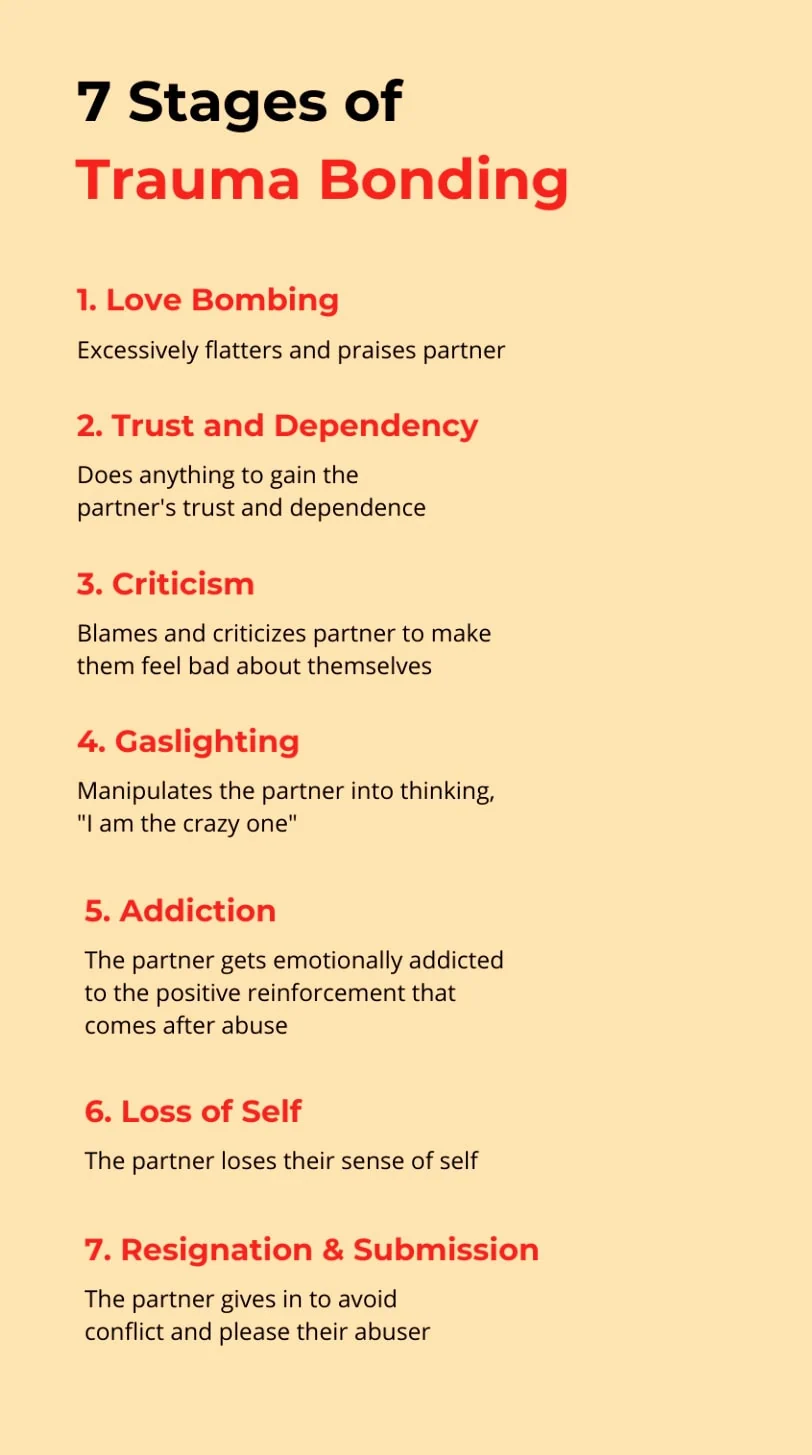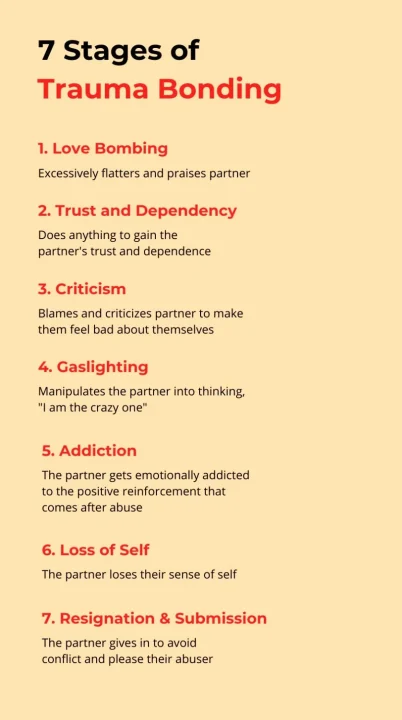Today's Monday • 15 mins read
— By Dr. Sandip Roy.
A wife always had trouble pleasing her narcissistic husband. If she made an omelette for breakfast, he would demand a poached egg. And an omelette if she poached an egg. Determined to please him, she made them both one day. As he sat down to eat, he looked at the two eggs and said, “You poached the wrong one.”
Abusers build strong emotional bonds with their victims. Their seven stages of trauma bonding train victims to crave toxic relationships after breakups.
Sometimes, people feel stuck in a bad relationship. They put up with it longer than necessary.
Worse, they leave and then return, not realizing they are addicted to a trauma bond.
A trauma bond is like a rubber band that pulls you back to your abuser.
So strong is its pull that the badly treated victim cannot walk out of this abusive relationship despite relentless insults and torture.
The victims constantly try to please their abuser, hoping to earn a few praises and kind words in return.
They don’t realize they have been trained in seven stages to feel exactly this way.
Let’s explore these stages that tie the victim to their abuser.
7 Stages of Trauma Bonding That Trap You In A Toxic Relationship
Trauma bonds are made of abuse, neglect, and punishment, with rare moments of love and care.
These are the 7 stages of trauma bonding in a relationship:

1. Love Bombing Stage: Creating The Illusion of Perfect Relationship
In the first stage, the abuser showers the victim with love, attention, gifts, and compliments, creating an illusion of a perfect partner.
This stage, known as love bombing, doesn’t look to feel like abuse on the surface.
On the contrary, it makes the unsuspecting victim feel special, valued, and important.
However, it is the most strategic move that lays the foundation for trauma bonding the victim.
This stage may vary in intensity and duration, depending on individual dynamics and cultural context.
(Find out how long can love bombing last in narcissistic relationships.)
2. Trust and Dependency Stage: Building A Strong, Unique Connection
Once the person targeted has been completely charmed by the abuser’s love bombing, they begin to grow a deeper trust in the abusive person.
The abuser skillfully manipulates the situation, giving sympathy, support, and understanding to solve the victim’s problems, making the victim feel dependent on them.
The trust and dependency stage often involves subtle coercion or gestures of “loving” control. They target making the victim slowly dependent on the abuser for making all their decisions and choices.
For example, they may say, “I won’t have my lunch unless you eat something.”
This dependency isn’t just emotional; it may extend to financial or other aspects. Even if someone leaves the relationship, they might go back just because they need money, not because they want to.
That is one reason we must have financial boundaries in our relationships.
The abuser creates a seemingly strong and unique connection, making the victim believe they’ve found an irreplaceable relationship.
3. The Abuse Cycle Stage: Start of Control, Devalue, Gaslighting, Discard
The abuse cycle stage starts with the victim being gradually exposed to greater and more intense emotional and physical trauma.
When Dutton and Painter (1981) first proposed “traumatic bonding,” they explained why these powerful emotional attachments form:
- Power imbalances: Most trauma-bonded relationships have a power imbalance. The more powerful partner exploits and assaults the vulnerable victim in these relationships.
- Intermittent good-bad treatment: The controlling partner builds a trauma bond through alternating cycles of aversive arousal (punishment) and relief (reinforcement).
i) Control
In the beginning, the abuser subtly takes control over various aspects of the victim’s life.
The first abusive incident might seem like a one-time mistake, happening during a time of novelty and optimism in the relationship.
Its relative lack of severity, coupled with the abuser’s remorse, can actually strengthen the emotional connection.
The victim may not yet believe that the abuse will be repetitive and inescapable, even when the abuser tells them something like:
“Why did you have your lunch when you know I haven’t eaten anything since morning?”
ii) Devalue
As the relationship progresses, the abuser begins to devalue the victim. They may belittle, criticize, or demean them, eroding their self-esteem.
The constant belittling lowers the victim’s self-esteem, making them more self-critical and giving negative self-reinforcement.
Repeated incidents of greater severity shift the victim’s thinking into believing that the violence will never stop unless they do something to prevent it.
But by then, they have already been trauma-bonded.
iii) Discard
Once trust and dependency have been established, the abuser may suddenly become distant, cold, and controlling.
This sudden shift creates a lot of distress and confusion in the victim. Yet, they stay optimistic that their abuser will revert to their earlier, loving behavior.
This stage can further deepen the trauma bond, as the victim clings to the hope of a return to the loving phase.
iv) Gaslighting
Alongside control, devaluation, and discard, the abuser uses gaslighting.
It is a cunning plot to gradually make the victim doubt their own memories, feelings, perceptions, judgments, and interpretations.
Gaslighting degrades the victim’s mental balance and sanity. They become overreliant on the abuser to grasp their own reality, which further cements the trauma bond.
The cycle of abuse, often marked by intimate partner violence, can have long-lasting effects on the victim’s psyche, making them behave like helpless dogs that whimper when electrically shocked.
4. Intermittent Reinforcement Stage: The “Slot Machine” Effect
This stage involves intermittent reinforcement or inconsistent reinforcement, a powerful tool in trauma bonding, leading to a hard-to-break emotional connection.
i) Intermittent Reinforcement Tactics
Intermittent reinforcement is a psychological tactic where the abuser alternates between kind and cruel behaviors. This binds the victim to the abuser.
- Think of a dog that is given a treat when it fetches a ball, but not every time.
- So, it keeps wagging its tail expecting to be given the chance to get the ball.
- Now, the dog’s main goal becomes retrieving the ball, rather than getting the treat.
Similarly, the victim’s addiction to the rare shows of kindness keeps them dutifully serving their abuser, overlooking the frequent cruelty.
Trauma bonding appears to be most potent when physical punishment is given at random intervals and mixed with moments of kindness and permission.
Fischer (1955) did an experiment with young dogs to suppress their social responses and found that the indulged-punished group showed 231% more human orientation than a consistently indulged group.
Rajecki and his team concluded that inconsistent treatment, meaning both abuse and love from the same source, leads to a heightened desire to be close to the object of attachment (Rajecki, et al., 1978).
ii) “Slot Machine” Effect
Intermittent reinforcement keeps victims engaged, as the unpredictability of rewards and punishments creates a “Slot Machine” effect.
It is how gambling houses create intermittent reinforcement by allowing near-wins, occasional wins, and “timed” payouts.
The uncertainty of the next win keeps players engaged and motivated to keep playing.
iii) Emotional Toll On The Victim
The victim’s emotional health worsens as they work harder to gain the abuser’s affection, only to be met with unpredictable responses like “half-praises” and “half-apologies.”
Feelings of helplessness and hopelessness become pervasive, leading to depression, anxiety, or other mental health symptoms.
The combination of isolation, self-blame, and intermittent reinforcement creates a toxic environment where the victim feels trapped, dependent, and emotionally broken.
iv) Gender and Cultural Factors
Gender and cultural factors may add layers of complexity to this stage.
The usually more powerful male narcissists and patriarchal societies are more likely to trauma bond women (sisters, daughters, and wives) in their relationships.
v) Victim’s Response and Behavior
The abuser keeps acting in an unpredictable, irregular way to punish or reward certain behaviors. This randomness makes the victim’s person-pleasing behavior more persistent, and resistant to break away from.
As a result, the victim has no idea when they will receive praise again, nor how long they will have to endure the ill-treatment. They eagerly look forward to the reward for acting like a slave to their master.
The uncertainty and inconsistency in the abuser’s responses create a cycle where the victim becomes increasingly desperate for approval, further deepening their dependency on the abuser.
vi) Scientific Insights
- Intermittent reinforcement occurs when a reinforcer is not given (the reward) every time the desired response occurs (Rollinson, 2011).
- When something has been learned because of intermittent reinforcement, the response seems to be remembered better and is more vigorous (Mills & Nankervis, 2013).
5: Submission Stage: Resignation To The Abuser’s Will
“By the time the woman realizes that the abuse is inescapable, the traumatically produced emotional bond is quite strong.” – Dutton & Painter (1993)
In the submission stage, the victim may become resigned to their situation, feeling totally dependent, trapped, and helpless, making it almost impossible to break free.
The abuser has, or will soon have, systematically isolated the victim from her friends, family, colleagues, and other social support systems. This might be subtle and gradual, with them criticizing, belittling, or gossiping about the victim’s friends or family.
It can also get more overt, and the abuser can start to dictate what the victim may wear, go, buy, eat, talk to, or socialize with.
They ultimately start controlling their victim’s whereabouts and communications, dictating to be always location tagged, all passwords revealed, and sharing every detail of their day.
Of course, this 24/7 monitoring comes with scoldings for doing the wrong things or doing things wrongly.
This social isolation increases dependency on the abuser, making the victim feel like there’s no one else to turn to.
Over time, the victim starts blaming themselves for the abuse, internalizing the abuser’s criticisms and accusations.
They may believe that they are at fault, that they deserve the abuse, or that they can change the abuser’s behavior by being “better.”
This internalization of blame intensifies the abuse cycle, further deepening the trauma bond and making it more challenging to recognize the abuse for what it is.
Overall, this stage increases the abuser’s control and decreases the victim’s autonomy.

6: Autonomy Erosion Stage: Loss of Sense of Self Identity
In this stage, the victim’s sense of self becomes profoundly eroded. It seems as if their entire existence revolves around their abuser.
They lose the ability to recognize or express their needs, desires, or boundaries. They are always trying to satisfy and outdo their “service” to their abuser.
Their identity becomes enmeshed with the abuser, and they prioritize the abuser’s needs and feelings over their own.
This loss of self is not merely a fading away of individuality; it’s a transformation where the victim’s thoughts, feelings, and actions are dominated by the abuser’s influence.
Leaving the relationship becomes nearly impossible without significant outside intervention or support.
Even when the abuser’s true nature is revealed, the victim may be reluctant to break up, and they may return to the relationship if they manage to break away.
This stage represents the completion of the trauma bond, where the victim’s autonomy is lost, and the bond becomes a defining aspect of their identity.
It’s a profound and tragic loss of a person’s self that often requires intensive support and therapy to overcome.
7: Emotional Addiction Stage: Loyalty-Seeking Abuser Alignment
In this final emotional addiction stage, the victim’s attachment to the abuser becomes more entrenched as they start to seek their abuser’s approval and validation.
They may begin to believe that they deserve the mistreatment or that the abuser’s actions are justified.
This loyalty is not merely passive acceptance; it’s an active alignment with the abuser’s worldview.
The stage is often compared to Stockholm Syndrome, where kidnapped victims sympathize with and support their captors.
The abused person becomes extremely loyal to their abuser, rationalizing their actions, protecting them from criticism, and even participating in their abusive behaviors.
They adopt the abuser’s distorted view of reality, accepting claims that the hurtful actions are beneficial and protective.
This alignment solidifies the trauma bond, making it more challenging to recognize the abuse and seek help.
Moreover, cultural contexts and faith-based dynamics can make things worse for trauma bond victims.
FAQs
How does a narcissist trauma bond with their victims?
Playing the Victim: Portraying themselves as misunderstood or victimized to gain sympathy and trust, making the victim feel responsible for their well-being.
Promises of Change: Making false promises to change or improve, giving the victim hope that things will get better, only to revert to abusive behavior.
Creating Dependency: Identifying and using the victim’s weaknesses to create dependency. Taking over financial resources to increase financial dependency.
Inconsistent Reinforcement: Alternating between kindness and cruelty to keep the victim on edge.
Withholding Affection: Controlling the victim by withholding love and approval.
Emotional Blackmail: Using guilt and emotional manipulation to control behavior and decisions.
Can trauma bonding occur without abuse?
In a power imbalance, the victim is bonded by an impending threat of abuse or violence.
In dependency situations, the victim may feel the threat of being abandoned by the person they are overly dependent on.
What does withdrawal from a trauma bond feel like?
Is there a test to determine trauma bonding?
Trauma Bonding Scale (Reid, 2023): This scale specifically targets trauma bonding and measures the attachment and loyalty to a person who is destructive or abusive in various relationships, including romantic, familial, or professional.
Stockholm Syndrome Scale (Graham, 1995): While not specifically designed for trauma bonding, this scale can assess symptoms that overlap with trauma bonding, such as loyalty to an abuser.
Dissociative Experiences Scale (DES): This scale can be used to assess dissociative symptoms, which may be present in individuals experiencing trauma bonding. Dissociation can be a coping mechanism in abusive relationships.
How does a trauma bond begin?
A trauma bond begins through a complex process that typically involves the following stages:
- Initial Connection: Often, the relationship starts positively, with the abuser showering the victim with affection and attention. This “love bombing” stage makes the victim feel special and valued.
- Trust and Dependency Development: The abuser skillfully manipulates the situation to create trust and dependency. They may exploit vulnerabilities and create a seemingly strong connection, making the victim feel reliant on them.
- Inconsistent Reinforcement: The abuser begins to alternate between kindness and cruelty. This inconsistency keeps the victim on edge, wanting to work harder to gain the abuser’s affection. It can lead to addiction-like symptoms, where the victim craves the abuser’s validation.
- Manipulation and Control: Tactics like gaslighting, isolation, and control are used to further cement the bond. The victim may start to question their memories, feelings, and perceptions, becoming reliant on the abuser for their understanding of reality.
- Erosion of Self-Worth: The victim’s self-esteem and self-worth may be eroded, leading to a belief that they deserve the abuse or cannot find better. This mindset further entrenches the trauma bond.
The formation of a trauma bond is a gradual and insidious process, often happening without the victim fully realizing what’s occurring. The combination of emotional highs and lows, manipulation, and control creates a powerful connection that can be challenging to break.
- Download a more detailed PDF of this post: 7 Stages of Trauma Bonding: Simply Explained
Final Words
Leaving a bad relationship is hard. The longer you are in a trauma-bonded relationship, the harder it might be to leave. You might keep going back to the same person who hurt you.
So, as soon as you realize you have been trauma-bonded, do these two things:
- Stop justifying their behavior (doing so makes you an enabler), and
- Distance yourself from the relationship with help from supportive people.
Reach out to therapists and counselors who specialize in relationship trauma.
Please tap into social support groups (even if it means talking to your local Alcoholics Anonymous), if you do not have the money. They can guide you on how to support yourself as you break out of your trauma bond.
√ Also Read:
- How To Break A Trauma Bond After A Breakup With An Abuser?
- Narcissistic Shame: Why & How Do Narcissists Feel Shame?
- 10 Signs of A Narcissistic Husband: Spot The Red Flags
√ Please spread the word if you found this helpful.
• Our Story!
